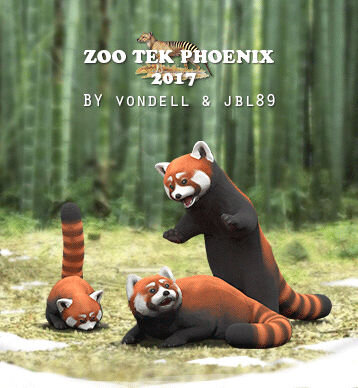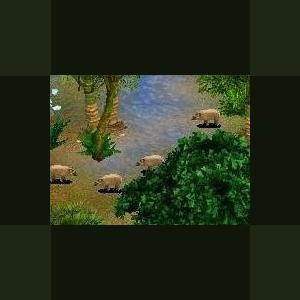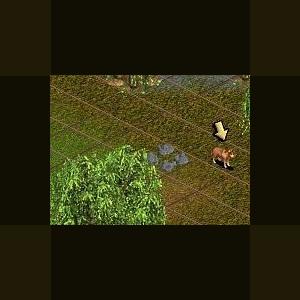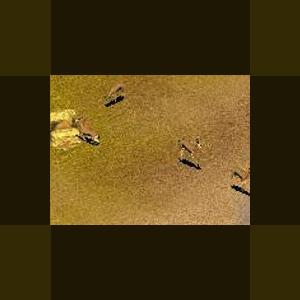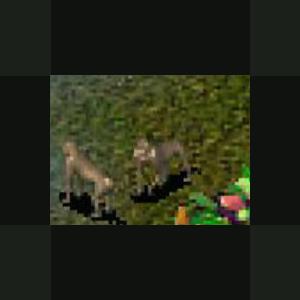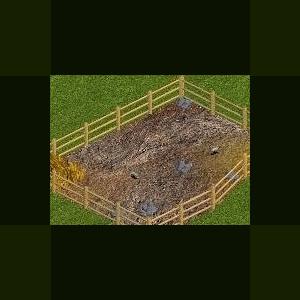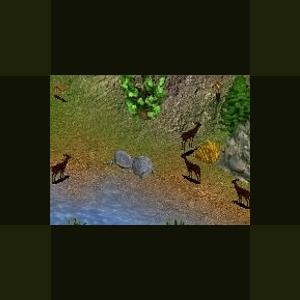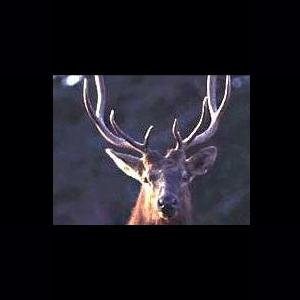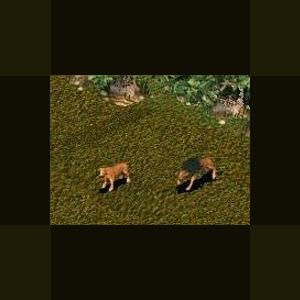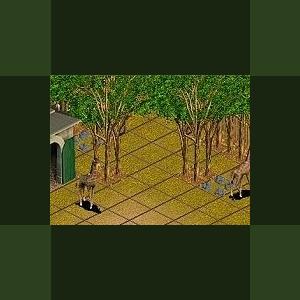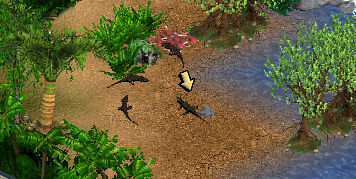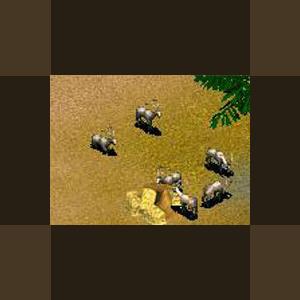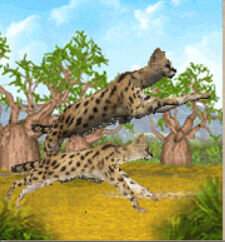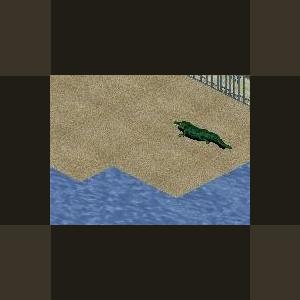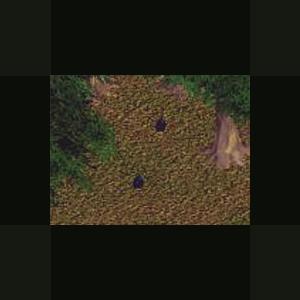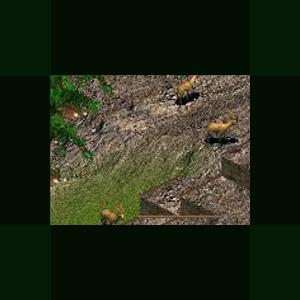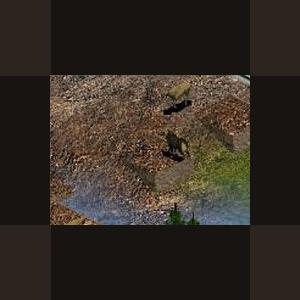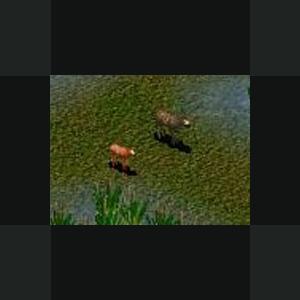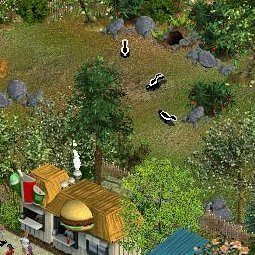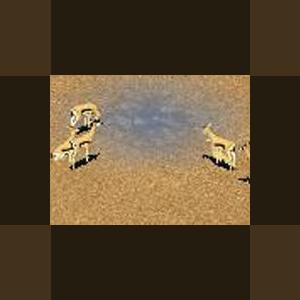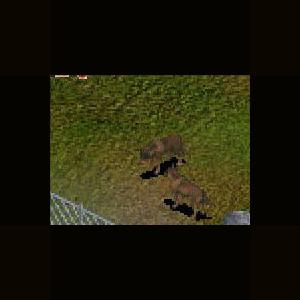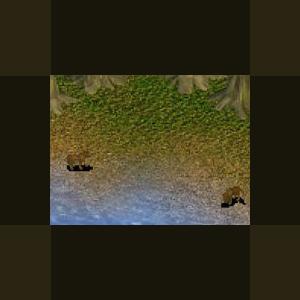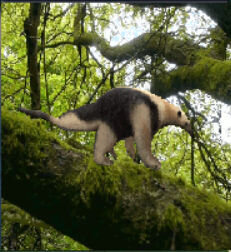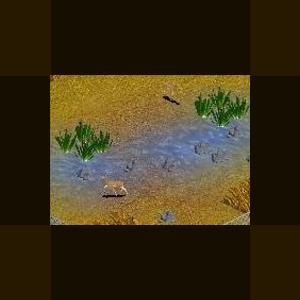279 files
-
Red Panda by Vondell and JBL89
By jbl89
The Red Panda is an original new endangered animal, compatible with Zoo Tycoon 1 (no expansion packs needed).
You might also hear this little critter's unique cry once in a while.
From Wikipedia: The red panda (Ailurus fulgens), also called the lesser panda, the red bear-cat, and the red cat-bear, is a mammal native to the eastern Himalayas and southwestern China. It has reddish-brown fur, a long, shaggy tail, and a waddling gait due to its shorter front legs; it is slightly larger than a domestic cat. It is arboreal, feeds mainly on bamboo, but also eats eggs, birds, and insects. It is a solitary animal, mainly active from dusk to dawn, and is largely sedentary during the day.
- Design by Vondell
- Configuration by Jeff
(to admins: please test this animal once more, I'm using a slightly different version which was stable in my game. Vondell's been active for a bit, but I'm sure he's okay with publishing this first version of the Red Panda)
1,108 downloads
Updated
-
Red River Hog by And 1
By Guest
made by And 1
The Red River Hog has a striking red fur. There is a vague, white line thats runs over the back. The animal has a blank face mask around the eyes, on the cheeks and on the jaws. The muzzle and the face are black. The hair on the jaw and the flanks is longer than on the rest of the fur.
The Red River Hog has length of 1 to 1.5 meter. The thin tail is 30 to 45 centimetres long. The boar is somewhat larger than the sow. Also, the male has recognizable humps/lumps on both sides of the muzzle and rather small, sharp battle cogs.
The Red River Hog is omnivorous. It eats mainly roots and turnips, and completes its diet with fruit, grasses, herbs and animal food such as eggs, dead animal and plant remains, insects, and lizards. To find the turnips, roots and insects, it tosses its large muzzle in the ground. In this way, Red River Hogs can cause much damage to agricultural plants.
The Red River Hog is mostly nocturnal. By day, they hide in dense bushes. After sunset, they roam around in troops, in search for food. The Red River Hog is a good swimmer but is unable to hold its breath for long.
They live in small troops of four up to twenty animals, comprising a male (boar), some adult sows and their piglets. The boar defends its harem aggressively against carnivores; the leopard is its most important enemy. Different troops merge sometimes and form groups of up to sixty animals.
Updated 2010-11-05
Just to save space with less in zip and smaller image.
Nothing new.
382 downloads
0 comments
Updated
-
Red Wolf by Coolperson5
By Guest
Red Wolf by Coolperson5
The Red Wolf (Canis Rufus) is a critically endangered member of the dog family. It lives in the South-eastern United States.Created by Coolperson5.
Updated 2010-11-05
Just to save space with less in zip and smaller image.
Nothing new.
364 downloads
0 comments
Updated
-
Red-fronted Gazelle by Ghirin
By Guest
Red-fronted Gazelle
Author: Ghirin
http://www.zoo-tek.com/forums/index.php?download=144
The red-fronted gazelle (Gazella rufifrons) inhabits the dry steppe region of the Sahel in north central Africa. These gazelles are more water dependent than other dry-land gazelles and thus follow the rains: north into the desert during the wet season and back to the southern end of their range during the dry season.
These gazelles prefer open habitat such as thornbush savanna and vegetation-covered dunes.
Created by Ghirin 2003
Updated 2010-11-05
Just to save space with less in zip and smaller image.
Nothing new.
276 downloads
0 comments
Updated
-
Rhesus Macaque by G2K
By Guest
Rhesus Macaque
Author: G2K
The Rhesus Macaque is among the most common monkeys in India. It is highly intelligent and has learned to adapt to almost all habitats. These range from near-desert to thick jungles, even mountains above the snowline at 2,500m. In India, where they are considered sacred and left unthreatened, they live successfully in agricultural and even urbanised areas. More than half of the Rhesus Macaques in Uttar Pradesh of Northern India live in cities and towns, raiding cultivated areas and rubbish dumps. In fact, they often become so fearless of humans that they can be a pest or even a danger to humans.
Updated 2010-11-05
Just to save space with less in zip and smaller image.
Nothing new.
297 downloads
0 comments
Updated
-
Rock Hyrax by Jordan
By Guest
The Rock Hyrax is a small African mammal that lives in large groups on rock outcroppings.
Updated 2010-11-05
Just to save space with less in zip and smaller image.
Nothing new.
324 downloads
0 comments
Updated
-
Rocky Mountain Gazelle by Ape
By Guest
This is a very cute little gazelle with dark brown adults, and pale brown young. They need a lot of rocks and elevation! Designed and made by Ape; icon, uca configuration, sounds and recoloring by Dr Rick.
This is a very cute little gazelle which is a must-have for any zoo. The adults are dark brown, and the young gazelles pale brown. They need a lot of rocks and elevation!
Designed and made by Ape; icon, uca configuration, sounds and recoloring by Dr Rick
(For the technical among you, the adult uses a .pal file made by DrR for the Australian Kelpie. DrR also made a pale brown .pal file for the young using a modification of Devona's method - a 255X255 square shaded dark-pale brown and put into a scenery object to make the pal. To get different coloured adults and young DrR adapted a method suggested by Jay for the Amazonian Bush Dog (setting up a complete new identity within the animal for the young animations).)
It works well and looks great - this is a really superb animal and a great idea!!
Updated 2010-11-05
Just to save space with less in zip and smaller image.
Nothing new.
231 downloads
0 comments
Updated
-
Roosevelt Elk by Jordan
By Guest
Roosevelt Elk (Wapiti)
Scientific Name:
Cervus elaphus roosevelti
Size:
Height. at shoulder 4½-5'
Length. 8-10'
Weight. males 600-1000 lbs. | females 350-650 lbs.
Characteristics:
Adaptations/Coloration. brown or tan above | darker underparts | rump patch & tail yellowish brown | males dark brown mane on throat
Antlers. males large, many-tined antlers up to 5' | females lack antlers
Behavior:
crepuscular | during rut males rub antlers on saplings & shrubs | antlers used as weapons in fights for females | dig wallows in ground with hooves & antlers
reproduction/life span
Breeding Season. "rut" late Aug-early Oct
Gestation. ~8½ months | cows leave herd to give birth to 1 calf (twins rare)
Calf. 30-35 lbs. | cow & calf return to herd ~1 wk
Diet:
primarily grazers | many plants
habitat/range
coastal & Cascade ranges of Pacific Northwest | summer found in high open mountain meadows | winter lower wooded slopes, often dense woods
Created by JordanMK.
A BIG 'Thank you' to LAwebTek for letting me use his Whitetail Deer as a base for this project.
Updated 2010-11-05
Just to save space with less in zip and smaller image.
Nothing new.
524 downloads
0 comments
Updated
-
Rose Lion by Ghirin
By Guest
The rose lion is a fantastic animal native to the broadleaf forests of Asia. This lion's unique fur color makes it a zoo favorite.
Created by Ghirin 2007
Updated 2010-11-05
Just to save space with less in zip and smaller image.
Nothing new.
327 downloads
0 comments
Updated
-
Rothschild Giraffe by Coolperson5
By Guest
This Giraffe is a critically endangered subspecies from Kenya and Uganda.
Updated 2010-11-05
Just to save space with less in zip and smaller image.
Nothing new.
424 downloads
Updated
-
Rough Neck Monitor by Khaydar
By Khaydar
Thanks for downloading the rough neck monitor lizard. Lives on mangroves alone or in small groups
237 downloads
Updated
-
Scimitar Horned Oryx by LAwebTek
By Guest
The scimitar-horned oryx (Oryx dammah), named for its scimitar-shaped horns, weighs up to 220 kg (480 lb). The scimitar-horned oryx inhabits the sub-desert lands - the transition zones between true desert (Sahara) and the Sahel, with a rainfall of under 200 mm (8"). It is found in rolling dunes, grassy steppes and wooded inter-dunal depressions. It very rarely penetrates either true desert or true sahel country.
The scimitar-horned oryx eats a variety of grasses, as well as fruit and leaves. It is well adapted to arid lands, being able to go for 9 - 10 months without drinking water. Oryx has a number of adaptations to life in the desert. It utilizes the moisture in the vegetation it eats and its specialized kidneys minimize the loss of water through urine. Perspiration is minimized by allowing its body temperature to increase as high as 46.5 deg C (116 deg F) before body heat begins to be dissipated through perspiration.
During the Middle Ages the scimitar-horned oryx was probably the most numerous larger mammal of the semideserts just south of the Sahara. It was distributed from Mauritania in the west to the Red Sea in the east. Even as late as the 1920's and 30's it was considered common over much of its range from the Atlantic to the Nile. By the 1950's its range was fragmented, although substantial numbers survived in some areas. By the late 1960's it occurred only in Chad, Mali, Niger and the Sudan. By the late 1970's it only survived in scattered populations. In 1980 it was reported that only in Chad did it still occur in any numbers, with a small group in Niger, and perhaps a few dozen in Mali and Sudan. By the mid-1980's it was said to be on the brink of extinction and by 1999, it was thought to be extinct in the wild, although there was a recent unsubstantiated sighting of four animals in northern Niger.
The original decline of the scimitar-horned oryx started with climatic changes that led to the drying out of the Sahara. As the desert expanded to north and to south, it was pushed northward and southward, and desertification divided it into two isolated populations. The northern group probably was never as common as the southern group. The northern group may have been exterminated before 1900, although it was also reported to have survived in Tunisia until 1935.
The decline of the southern group worsened beginning with the arrival of Europeans in western and westcentral Africa in the latter part of the 19th century and the installation of numerous military posts in the arid regions. As firearms and horses increased, and then motorized vehicles, hunting began to take a major toll. The hunting was carried out by nomads for meat and hides for domestic consumption and trade, and by oil surveyors and troops. Not only were animals shot from motorized vehicles, sometimes with automatic weapons, but many of the slow-running desert animals died of heat exhaustion, calves were abandoned in the chase and unborn young aborted. In WWII, military operations probably led to considerable additional hunting to feed the armies. Finally, the civil war which began in Chad in the 1960's had a serious effect. In addition to the major impact of overhunting, the increasing presence of livestock, stimulated by deep wells for watering cattle on the edge of the Sahel, drove the oryx away from the pastures where it formerly obtained both food and water.
Currently, wild populations exist only in Israel (introduced populations), Tunisia (re-introduced populations) and a possible few may still occur in Niger.
2003 LAwebTek
Updated 2010-11-06
Just to save space with less in zip and smaller image.
Nothing new.
335 downloads
0 comments
Updated
-
Serval
By Khaydar
Adopt a Serval ( Leptailurus serval) for your zoos.
Animal guide:
Minimum happiness needed for chance of breeding: 97.
Liked foliage:
Savannah foliage
Liked rock:
Large Rock, Small Rock - Medium, Small Rock - Small
Animal can jump.
Animal can climb cliff.
Number of animals allowed per exhibit:
1-2 with 18 squares each.
A suitable exhibit for 2 of this animal has 36 squares containing terrain of:
26 Savannah Grass, 4 Sand, 4 Dirt, 2 Fresh Water
using 6 grid squares filled with 4 Tall Grass most liked plant
and using 19 Small Rock - Small most liked rock.
Preferred shelter:
Large Burrow.
Other liked items:
Waterfall Rock
381 downloads
- living animal
- khaydars animal
- (and 1 more)
Updated
-
Sewer Gator by Flames the Dragon
By Guest
Sewer Gator by Flames the Dragon
The Sewer Gator a fine addition to your zoos!
Updated 2010-11-06
Just to save space with less in zip and smaller image.
Nothing new.
Updated Jul 24, 2013 by JohnT: The warning has been corrected concerning the foliage not being listed in the uca.
192 downloads
0 comments
Updated
-
Siamang by Ghirin
By Guest
The siamang (Hylobates syndactylus) is the largest species of gibbon. They inhabit both primary and secondary forests and range from the Malay penninsula to Sumatra. The major portion of their diet is composed of leaves, but they aslo eat fruit, flowers, and a small amount of animal prey.
Siamangs, like other gibbons, are territorial. A pair establishs and defends a territory from others. They tolerate immature offspring in the family area until the offspring reach puberty; then the young leave to establish their own home territories.
Siamangs have loud calls. The male inflates his throat sac to scream a call while the female barks her calls.
References:
http://www.bbc.co.uk/nature/wildfacts/factfiles/344.shtml
Walker's Mammals of the World, Nowak, 1999
Photograph:
http://www.bbc.co.uk/nature/wildfacts/factfiles/344.shtml
Created by Ghirin 2003
Updated 2010-11-06
Just to save space with less in zip and smaller image.
Nothing new.
318 downloads
0 comments
Updated
-
Siberian Ibex by Ghirin
By Guest
The Siberian Ibex (Capra sibirica, Capra ibex sibirica) is a heavy-bodied wild caprid found in the mountain ranges of Central Asia, from the inner Himalayas to Mongolia. Like other wild goats, Siberian ibex prefer the higher elevations (up to 5000 meters), usually climb down to lower elevations during winter months.
This ibex is stout-bodied when compared to other species of wild goats. The fur color is variable, but is generally light tan and lacks the contrasting black and white markings on the legs. Both sexes have horns, with the horns of the males being much heavier, having several knobs on the front, and often curving backwards in pronounced arcs.
Siberian ibex are gregarious animals. Adult females and their young gather in herds of seven to thirty animals. Males form bachelor herds of similar sizes. Most feeding activity occurs during early morning and late afternoon.
Created by Ghirin 2003
Updated 2010-11-06
Just to save space with less in zip and smaller image.
Nothing new.
225 downloads
0 comments
Updated
-
Siberian Snow Sheep by Ghirin
By Guest
Siberian Snow Sheep
Author: Ghirin
The snow sheep of northern Siberia are closely related to the thinhorn and bighorn sheep of North America, more so than they are related to the argali or urial of the central Asian highlands. These sheep are divided into several subspecies which inhabit various mountain ranges in northeastern Siberia. They graze in the alpine meadows and retreat to the rocky highlands when threatened.
Created by Ghirin 2003
Updated 2010-11-06
Just to save space with less in zip and smaller image.
Nothing new.
299 downloads
0 comments
Updated
-
Sitatunga by Ghirin
By Guest
Sitatunga by Ghirin
The sitatunga, also known as the marshbuck, (Tragelaphus spekeii) is found in Central Africa.
It is well-adapted to living in swamps and marshy areas, with a waterproof coat and long hooves.
Male sitatungas are dark brown in color, while the females have reddish coats. White markings are present in both sexes.
References:
www.wikipedia.org
http://www.awf.org/content/wildlife/detail/sitatunga
*Inspired by the Zoo Tycoon Brains Trust at the Zoo Tycoon Forums*
Updated 2010-11-06
Just to save space with less in zip and smaller image.
Nothing new.
308 downloads
0 comments
Updated
-
Skunk by msc3323
By Fern
Skunk by msc3323
Allowedly the Striped Skunk is not one of my best animals, but it can walk and stand. Here it is for your zoo-building pleasure :D
201 downloads
Updated
-
Slender-horned Gazelle by Ghirin
By Guest
The slender-horned gazelle can survive in both stony and sandy desert. Its hooves are broadened for ease of travel over sand and it can obtain all of its water from the plants it eats, but will drink if water is available. Other adaptations for desert survival include the pale pelage and a special structure in the nose for cooling blood.
To avoid the heat of the day, slender-horned gazelles feed during the night and early morning. They range widely in search of food, usually traveling in herds of 3 to 10 animals.
References:
http://www.animalinfo.org/species/artiperi/gazelept.htm
http://www.livingdesert.org/sgslenderhornedgazelle.html
http://www.ultimateungulate.com/Artiodacty...leptoceros.html
Photograph:
http://www.mindspring.com/~zoonet/galleries/gazelle.htm
Updated 2010-11-06
Just to save space with less in zip and smaller image.
Nothing new.
298 downloads
0 comments
Updated
-
Sloth Bear by Khaydar
By Khaydar
Adopt a Sloth Bear (Melursus ursinus) for your zoos.
Sloth Bear description:
Cannot be used in original Zoo Tycoon: Requires DD
Minimum happiness needed for chance of breeding: 95.
Liked foliage:
Rainforest Fern, Mangrove Tree, Foxtail Palm Tree
Liked rock:
Large Rock, Small Rock - Medium, Small Rock - Small
Animal can jump.
Animal can climb objects.
Animal can climb cliff.
Number of animals allowed per exhibit: 1-3 with 35 squares each.
A suitable exhibit for 2 of this animal has 70 squares containing terrain of:
42 Rainforest Floor, 14 Dirt, 14 Grass
using 14 grid squares filled with 4 Foxtail Palm Tree most liked plant
and using 20 Small Rock - Small most liked rock.
Of the 70 squares, 1 nonadjacent squares should be elevated.
Preferred shelter: Rock Cave.
Other liked items:
Waterfall Rock, Cat Climbing Tree
Credits to DutchDesigns for the model and mesh
Made by Khaydar
176 downloads
- khaydars animal
- bear
- (and 1 more)
0 comments
Updated
-
Small-eared Dog by BigCatKeeper
By Guest
Small-eared Dog
Author: BigCatKeeper
Also known as the Small-Eared Fox, Small-Eared Zorro, Short-Eared Fox, and Dusicyon Microtis.
They have a thick, stocky body set on relatively short narrow legs. Their muzzle is very long and thin, with short, rounded ears set to the sides of the head. They range from dark reddish-grey to black on their backs, blending to a rufous color underneath. Their undersides have pale-colored parts. Their bushy tail has very thick, black hair.
Their paws are partially webbed, suggesting that they may be somewhat aquatic.
Average height is 10 in. (25 cm), weighing 22 lb (10 kg).
Small-Eared Dog can be either nocturnal or diurnal, and natives report that they are solitary. For the most part, they seem to be docile and non-aggressive towards humans. Males seem to have a musky odour that females do not.
The most urgent threat to this dog is habitat loss, since they only thrive in areas undisturbed by humans. Jaguars, ocelots and cougars are all potential predators of this much smaller fox.
Small Eared Dog created by Bigcatkeeper
Updated 2010-11-06
Just to save space with less in zip and smaller image.
Nothing new.
251 downloads
0 comments
Updated
-
South American Bush Dog by Ghirin
By Guest
The bush dog (Speothos venaticus) of South and Central America is a very unusual canine.
It has a long body on short legs. Bush dogs inhabit rainforests and wet savannahs of that region. They are excellent hunters and also will pursue prey into the water.
Bush dogs are very social animals, living and hunting in packs of up to 10 individuals. They are among the most carnivorous of all canines. Their main prey animals are rodents such as pacas and agoutis.
Updated 2010-11-06
Just to save space with less in zip and smaller image.
Nothing new.
314 downloads
0 comments
Updated
-
Southern Anteater by Khaydar
By Khaydar
Adopt a Southern Anteater (Tamandua tetradactyla) for your zoos.
Southern Anteater description:
Cannot be used in original Zoo Tycoon: Requires DD
Minimum happiness needed for chance of breeding: 95.
Liked foliage:
Ulmo Tree, Llala Palm Tree, Kapok Tree
Animal can climb objects.
Animal can climb cliff.
Number of animals allowed per exhibit: 1-3 with 15 squares each.
A suitable exhibit for 2 of this animal has 30 squares containing terrain of:
24 Rainforest Floor, 2 Grass, 3 Dirt, 1 Fresh Water
using 4 grid squares filled with 4 Ulmo Tree most liked plant
and using no rocks.
Preferred shelter: Large Burrow.
Credits to Hendrix and Zerosvalmont for the model and mesh
Made by Khaydar
217 downloads
- living animal
- anteater
- (and 1 more)
Updated
-
Southern Reedbuck by Jordan
By Guest
The Southern Reedbuck is an antelope that lives along rivers in southern Africa.
Updated 2010-11-06
Just to save space with less in zip and smaller image.
Nothing new.
284 downloads
0 comments
Updated

